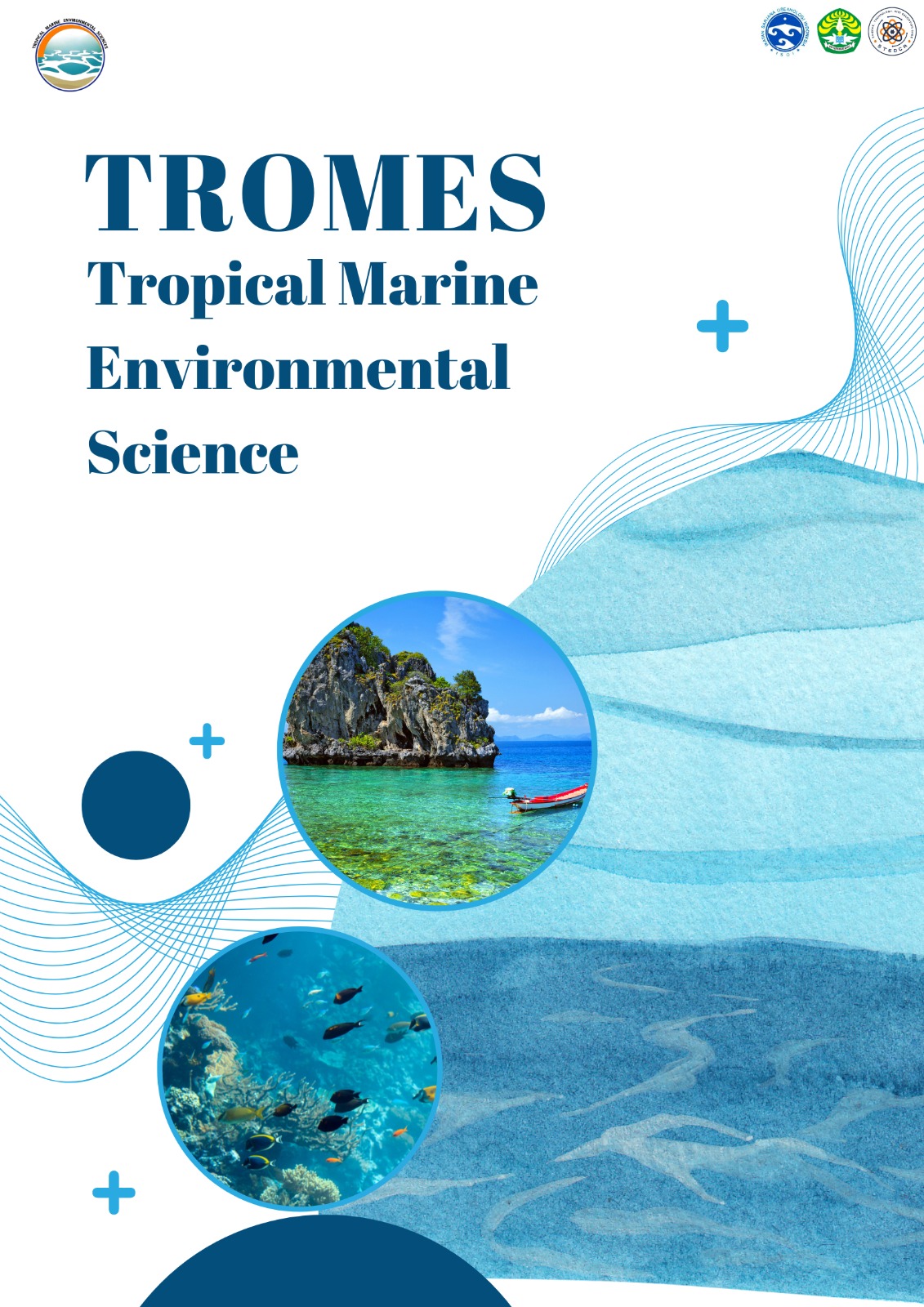Population Growth and Chlorophyll Content of Spirulina platensis Fertilized with Azolla microphylla
DOI:
https://doi.org/10.31258/tromes.1.1.1-7Keywords:
Liquid Fertilizer, Macrophites, Organic Fertilizer, Microalgae, Water FernAbstract
Spirulina platensis is a marine microalga that has potential as a natural fish feed and is considered an absolute food supplement to combat malnutrition in some countries. Azolla microphylla is a water fern that has been cultivated, contains high protein, grows quickly and is widely found in tropical waters. This study analyzed the effect of liquid fertilizer of A.microphylla on population growth and chlorophyll content of S. platensis. A completely randomized design (CRD) was used and the treatments were A (3 mL/L), B (5 mL/L) and C (7 mL/L), D (negative control without liquid fertilizer) and E (positive control, addition of 1 ml/L Walne fertilizer). The measurement results showed that the water quality during the study was in good condition, the water temperature ranged from 28-29 C, pH (7-8) and salinity (25 - 26 ppt). The highest population density level of S. platensis (321,500 cells/mL) was recorded in treatment B. Then followed by treatment D (270,600 cells/mL), treatment C (260,000 cells/mL), treatment A (220,000 cells/mL) and treatment E (150,000 cells/mL). The highest chlorophyll content was found in treatment C of 0.362 g/L, treatment D (0.302 g/L), treatment A (0.182 g/L), treatment B (0.250 g/L), and treatment E (0.072 g/L).
Downloads
References
Abdel-Tawwab, M & H.S. Hamed. (2020). Antagonistic effects of dietary guava (Psidium guajava) leaves extract on growth, hemato-biochemical, and immunity response of cypermethrin-intoxicated Nile tilapia, Oreochromis niloticus, fingerlings. Aquaculture, 529,735668
Adams, M. (2005). Superfood for optimum health: Chlorella and Spirulina. New York: Truth Publishing International Ltd. Page 26.
Adharani, N., Citra. S.C., Hidayat, N.B., Susanto, A.H., Saputra, A. (2017). Modification of bean sprout and urea media to Spirulina platensis culture. Proceeding The 1st IBSC: Towards the Extended Use of Basic Science For Enhancing Health, Environment, Energy and Biotechnology. Food Technology. 107-109.
Albab, M. (2017) Pengaruh konsentrasi pupuk cair Azolla pinnata terhadap kepadatan populasi dan kandungan protein Spirulina platensis. Skripsi. Fakultas Pertanian-Peternakan Universitas Muhammadiyah Malang, 2017.
Ali, S.K., Saleh, A.M. (2012). Spirulina platensis- An Overview. Internasional Journal of Pharmacy and Pharmaceuntical Sciences. 4 (3) : 9-15.
Barus, W.A., Utami, S., Azmi, P.A. (2018). Effect of Azolla Bokashi and Liquid Organic Fertilizer of Goat Manure on the Growth and Production of Chinese Kale (Brassica oleracea L.). Indonesian Journal of Agricultural Research 01 (01): 78 – 86.
Belay, A. (2008). Spirulina (Spirulina sp.) Production and Quality Assurance, in Gershwin, M.E and Belay A (Eds.). Spirulina in Human Nutrition and Health, CRC Press, California, 2-26.
Bezerra, P., Montoya, R., Ortiz, E.Y., Sunao, S., Perego Patrizia, Carvalho, J.C.M., Attilio, A. (2011). Effects of light intensity and dilution rate on the semicontinuous cultivation of arthrospira (Spirulina) platensis. A kinetic monod-type approach. Bioresour. Technol. 102, 3215–3219.
Danesi, E.D.G., Rangel-Yagui, C.D.O., De Carvalho, J.C.M., Sato, S. (2002). An investigation of the effect of replacing nitrate by urea in the growth and production of chlorophyll by Spirulina platensis. Biomass Bioenergy, 23(4): 261–269.
Dianursanti, D., Zarahmaida, T., Indraputri, C.M. (2018). Optimization growth of Spirulina platensis in bean sprouts extract medium with urea fertilizer for phycocyanin production as antioxidant. Proceedings of the International Symposium of Biomedical Engineering (ISBE) 2017 - Bali, Indonesia (25–26 July 2017). doi:10.1063/1.5023961.
Effendi, I., Nurrachmi, N., Tarigan, A.N.F. (2021). Growth of Microalgae Spirulina platensis on Media Containing Palm Oil Mill Effluent. IOP Conf. Series: Earth and Environmental Science 695 (2021) 012039. doi:10.1088/1755-1315/695/1/012039.
Effendi I, Pranata A, Feliatra F (2019) The Effect of sun light intensity on the growth of Azolla hidrophylla and its Symbiont Anabeana azollae in brackish water. Journal of Physics: Conference Series 1351 012096. IOP Publishing. doi:10.1088/1742-6596/1351/1/012096.
Effendi, I., Saputra, E., Tanjung, A., Elizal. (2020). Adaptation of Azolla hidrophylla to Brackish Water Ecosystem. International Conference on Environment and Technology. IOP Conf. Series: Earth and Environmental Science 469 012024. IOP Publishing. doi:10.1088/1755-1315/469/1/012024.
Gonçalves, A.L., Rodrigues, C.M., Pires, J.C.M., Simões, M. (2016). The effect of increasing CO2 concentrations on its capture, biomass production and wastewater bioremediation by microalgae and cyanobacteria. Algal Res. 14, 127–136.
Hanryani, P., Efriyeldi., Effendi, I. (2019). The effect of different light colours on the biomass growth of Spirulina platensis. Asian Journal of Aquatic Science. 2(2): 132-137.
Huesemann, M., Crowe, B., Waller, P., Chavis, A., Hobbs, S., Edmundson, S., Wigmosta, M. (2016). A validated model to predict microalgae growth in outdoor pond cultures subjected to fluctuating light intensities and water temperatures. Algal Res. 13, 195–206.
Leksono, A.W., Dian, M., Indah, A.Y. (2017). Penggunaan Pupuk Cair Hasil Fermentasi dari Azolla pinnata Terhadap Kepadatan Sel Spirulina sp. Jurnal Ilmu-ilmu Perikanan dan Budidaya Perairan. 12(1): 56-65.
Lestari, S.U., Mutryarny, E., Susi, N. (2019). Azolla mycrophylla fertilizer for sustainable agriculture: compost and liquid fertilizer applications. International Journal of Scientific & Technology Research, 8(07):542-547.
Mutia, S., Nedi, S., Elizal. (2021). Effect of nitrate and phospate concentration on Spirulina platensis with indoor scale. Asian Journal of Aquatic Sciences, 4 (1): 29-35.
Nainggolan, J.G.M., Tanjung, A., Effendi, I. (2018). Pertumbuhan biomassa Spirulina platensis dengan pemberian nutrisi yang berbeda dengan skala indoor dan semi out door. Asian Journal of Aquatic Science. 2(1): 22-28
Natalia N. Amin B, Effendi I (2019) Effect of addition of different nitrate concentration on Spirulina platensis biomass with semi outdoor system. Asian Journal of Aquatic Sciences, 2(2): 127-131.
Sajjad, H., Al-Bdairi, J., Jawad, K.A. (2021). The effect of biofertilizer of Azolla, phosphate and nitrogen fertilizers on some growth traits of rice. IOP Conf. Series: Earth and Environmental Science 735 (2021) 012064. doi:10.1088/1755-1315/735/1/012064.
Salunke, K.J., Magar, S.A., Joshi, R.R., Wadikar, M.S. (2016). Comparative study on the growth of Spirulina platensis on different culture media. Biosci. Discov. 7 (1): 90–92.
Sari, H.S., Endang, D.M. (2012). Effect of azolla pinnata fertilizers on chlorophyll content of Spirulina platensis. Universitas Airlangga.
Schroder, J.J., Chordell, D., Smith, A.L., Rosemarin, A. (2010). Suistainable Use of Phosphorus. Plant Research International, Part of Wageningen Ur. Business Unit Agrosystem.
Setiawati, M.R., Damayani, M., Herdiyantoro, D., Suryatmana, P., Anggraini, D., Khumairah, F.H. (2017) The Application dosage of Azolla pinnata in fresh and powder form as organic fertilizer on soil chemical properties, growth and yield of rice plant. The 1st International Conference and Exhibition on Powder Technology Indonesia (ICePTi) 2017.
Soni, R.A., Sudhakar, K., Rana, R.S. (2019). Comparative study on the growth performance of Spirulina platensis on modifying culture media. Energy Reports 5 (2019); 327-336.
Soni, R.A., Sudhakar, K., Rana, R. (2016). Biophotovoltaics and biohydrogen through artificial photosynthesis: an overview. Int. J. Environ. Sustainable Dev. 15 (3).
Sudhakar, K., Premalatha, M. (2015). Characterization of microalgal biomass through FTIR/TGA/CHN analysis: application to scenedesmus sp. Energy Sour. A 37 (18): 1–8. http://dx.doi.org/10.1080/15567036.2013.825661.
Sudhakar, K., Premalatha, M. (2012). Micro-algal technology for sustainable energy production: state of the art. J. Sustainable Energy Environ. 3: 59–62.
Widiastuti, D.P., Davis, J.G., Gafur, S. (2016). Azolla fertilizer as an alternative N source for red spinach production on alluvial and peat soils in West Kalimantan, Indonesia. International Nitrogen Initiative Conference, Solutions to improve nitrogen use efficiency for the world, 4 – 8. December 2016, Melbourne, Australia





